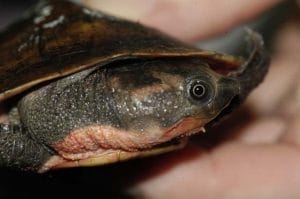Elseya kalumburu (Kalumburu Snapping Turtle)
Home > Turtle Database > Elseya kalumburu (Kalumburu Snapping Turtle)
Elseya kalumburu is a species of freshwater turtle found in northern Australia. Known for its distinct appearance, this turtle is primarily found in the rivers and streams of the Kimberley region. It plays an important role in its ecosystem and is part of the Chelidae family, which is characterized by side-necked turtles.
Native To These Regions
Western Australia (Australia)Native Turtle Species Map – Find Turtles by Region
Scientific Classification
- Kingdom: Animalia
- Phylum: Chordata
- Class: Reptilia
- Order: Testudines
- Family: Chelidae
- Genus: Elseya
- Species: Elseya kalumburu
Common Names
Kalumburu Turtle
This Hilarious Turtle Book Might Know Your Pet Better Than You Do
Let’s be real—most turtle care guides feel like reading a textbook written by a sleep-deprived zookeeper.
This one’s not that.
Told from the snarky point of view of a grumpy, judgmental turtle, 21 Turtle Truths You’ll Never Read in a Care Guide is packed with sarcasm, sass, and surprisingly useful insights.
And hey—you don’t have to commit to the whole thing just yet.
Grab 2 free truths from the ebook and get a taste of what your turtle really thinks about your setup, your food choices, and that weird plastic palm tree.
It’s funny, it’s honest, and if you’ve ever owned a turtle who glares at you like you’re the problem—you’ll feel seen.
Identification
Description
The Elseya kalumburu has a broad, flattened carapace that ranges from dark brown to black in color. Its shell features slight serrations along the edges and it has a short, robust neck. The turtle’s head is relatively large, with a broad snout and light-colored patches on the sides of its face.
Sexual Dimorphism
Females are generally larger than males, reaching sizes up to 30 cm in carapace length. Males tend to have longer, thicker tails, which is a common sexual characteristic in freshwater turtles.
Check more turtles from the Elseya genus
Native Origin and Distribution
Geographical Range
This species is endemic to the Kimberley region in northern Western Australia. It is typically found in the rivers and streams around the Kalumburu community, which is how it got its name.
Preferred Habitat
The Elseya kalumburu prefers slow-moving freshwater habitats such as rivers, creeks, and lagoons. These bodies of water are often surrounded by dense vegetation, which provides cover and food for the turtle.
Behavior
Feeding Habits
This species is omnivorous, feeding on a mix of plant material, such as aquatic vegetation, and small invertebrates, including insects and mollusks.
Predators
Juvenile turtles are often preyed upon by birds of prey, large fish, and monitor lizards. Adult turtles have fewer predators, though crocodiles and humans can pose a threat.
Reproduction
Breeding Season
Breeding generally occurs during the dry season, with females laying eggs in nests dug in sandy areas near water sources.
Reproductive Method
The turtle lays clutches of 10-15 eggs, which incubate for several months before hatching. The temperature of the nest plays a significant role in determining the sex of the hatchlings.
Conservation
Extinction Status
Currently, Elseya kalumburu is not listed as endangered, though its population is considered vulnerable due to habitat changes and human activities.
Threats
The primary threats to this species include habitat destruction due to agricultural expansion, water pollution, and predation by introduced species such as feral pigs.
Conservation Measures
Efforts to conserve this species include habitat protection, monitoring of population trends, and community education programs to prevent the destruction of nests.
Economic Importance
The Elseya kalumburu has little direct economic importance but contributes to the ecological balance of freshwater ecosystems by controlling the population of aquatic plants and small invertebrates.
Interesting Facts
- This turtle is part of the Chelidae family, also known as side-necked turtles, meaning it retracts its head sideways into its shell rather than pulling it straight back.
- The species is named after the Kalumburu community, highlighting its limited geographical range.
- Unlike many other turtle species, Elseya kalumburu is less commonly kept in captivity due to its specific habitat requirements.

About Author
Muntaseer Rahman started keeping pet turtles back in 2013. He also owns the largest Turtle & Tortoise Facebook community in Bangladesh. These days he is mostly active on Facebook.















